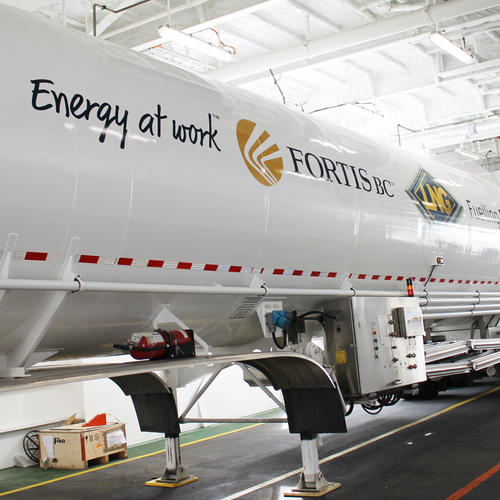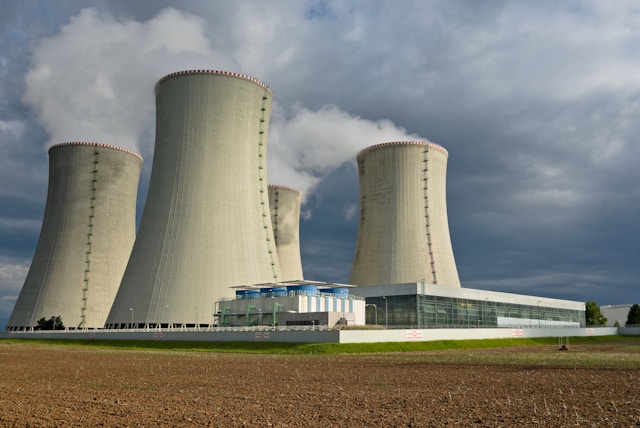Canada’s LNG era officially begins

FortisBC and Ferus NGF are proving a dynamic domestic LNG industry already exists in Canada and it’s growing. — Photo courtesy FortisBC The pop of a
FortisBC and Ferus NGF are proving a dynamic domestic LNG industry already exists in Canada and it’s growing. — Photo courtesy FortisBC
The pop of a starter pistol echoed across Canada on October 1, 2018 when LNG Canada partners Royal Dutch Shell, PETRONAS, PetroChina Co. Ltd., Mitsubishi Corp. and Korea Gas Corporation announced a final investment decision (FID) to build their $40-billion LNG export facility in Kitimat, B.C. The announcement marked a significant turning point for Canada’s beleaguered energy industry.
Included in that hefty price tag is the $6.2-billion Coastal Gaslink pipeline to be built and operated by TC Energy that will transport 2.1 bcf/d of natural gas from BC’s prodigious gas fields near Dawson Creek. Expected to be in service by 2023, Coastal Gaslink has a design capacity of 5.0 bcf/d.
LNG Canada’s facility, expected to be fully commissioned in 2025, is approved for two LNG trains with potential expansion to four. CEO Andy Calitz speaking in Houston was reported as saying that expansion could happen before the facility is finished construction.
Likewise, Kitimat LNG, another of the eighteen LNG export facilities proposed across Canada, recently submitted a revision to expand capacity at their proposed facility. Partners Chevron Canada Limited and Woodside Energy International (Canada) Limited added another intriguing alteration to the project; electric trains.
A train is the guts of an LNG plant, purifying, compressing and liquefying the raw natural gas into 99 per cent pure, liquid methane chilled to -160 degrees Celsius. There are two types of LNG trains; mechanical, powered by natural gas and electrical. Electric trains are expensive but when powered by hydroelectricity, as proposed by Kitimat LNG, could make this one of the lowest greenhouse gas emitters per tonne. If built. And greenhouse gases are the crux of the LNG gambit. While not a cure for the world’s carbon problem, methane offers lower emissions than existing fuels like coal or diesel. FortisBC is at the forefront of one such transition.
“Both [BC Ferries and Seaspan Ferries] required onboard bunkering solutions for their new LNG ferries, similar to their existing diesel bunkering solution,” said Arvind Ramakrishnan, senior manager of natural gas for transportation and regional LNG at FortisBC.
“We developed proprietary tanker truck technology to deliver [LNG] fuel by driving onboard a vessel. [It] is the first of its kind in the world.”
“Seaspan estimates its CO2 emissions will be reduced by approximately 22 per cent,” said Ramakrishnan, “while BC Ferries expects to … reduce its emissions by 21,500 tonnes annually – the equivalent of taking approximately 4,400 vehicles off the road.”
Apply those reductions to the entire shipping industry and the impact would be substantial. About 3,000 ships enter the Port of Vancouver annually, the third busiest North American port by tonnage. Most trans-Pacific vessels fuel in Asia.
“Conventional fuel prices on the west coast are higher than that of many international ports, which results in many shipping companies avoiding Canadian ports for fuel,” said Ramakrishnan, adding, “converting just one to LNG would result in emissions reductions equivalent to taking nearly 20,000 gasoline-powered vehicles off BC roads each year.”
By offering lower-emission, cost-competitive LNG fuel, FortisBC sees an opportunity to make Vancouver an LNG marine bunkering hub. With the International Maritime Organization (IMO) ruling that marine sector emissions be slashed starting in 2020, LNG is one of several fuel alternatives for the global shipping fleet.
LNG has another benefit as a greener replacement to oil-derived fuels.
“If spilled, LNG would not result in a slick because 100% of it evaporates leaving no residue behind,” opined Ramakrishnan.
That’s appealing to both marine and terrestrial customers, the latter of whom are also seeking lower emissions alternatives to diesel. There are impediments though. While commercial and long-haul transportation fleets are ideal candidates for LNG conversion, a lack of heavy horsepower engines and public refueling infrastructure is limiting adoption.
The outlook remains brighter elsewhere in the domestic LNG industry. FortisBC’s Tilbury Island LNG facility in Delta, B.C. has been transporting LNG to northern communities such as Whitehorse and Inuvik to offset diesel-fueled power generation since 1997. This market is growing rapidly and, along with small-scale overseas export potential, inspired FortisBC to expand Tilbury Island’s capacity by a factor of seven.
Converting power-generation away from diesel in northern communities is attracting others like Ferus NGF in Alberta. Initially a cryogenics firm supplying liquefied CO2 and nitrogen to the petroleum industry, adding LNG to the mix was a natural fit.
“We believed that the oil and gas industry would be amongst the first adopters of natural gas as an alternative fuel to diesel since they were so familiar with [it],” said Blaire Lancaster, vice president of business development and external affairs at Ferus.
That belief led Ferus to build a facility in Elmworth, Alberta providing LNG “to fuel drilling rigs and to fuel frac spreads,” said Lancaster.
From oil and gas, Ferus expanded into fueling power generation in northern communities and mining operations, a sector now commanding 50 per cent of their LNG business.
At the other end of the LNG spectrum, the situation isn’t as rosy. Canaport LNG, a $1-billion joint venture by Irving Oil and Respol located near Saint John, N.B., is the only waterborne LNG import facility in Canada.
Built to sendout 1.2 bcf/d, Canaport LNG took first shipment in 2009 but the shale gas boom currently fueling the LNG export industry on the west coast was already upending the east coast gas market Canaport aimed to supply. At its peak in 2011, sendout was only 324 mmcf/d; by 2014 it was 39 mmcf/d.
That’s a cold lesson in the fickleness of petroleum markets. As shovels hit dirt in Kitimat, it would be wise to temper enthusiasm with a cautious optimism.
Still, as FortisBC and Ferus NGF are proving, a dynamic domestic LNG industry already exists in Canada and it’s growing. The LNG era is upon us.



